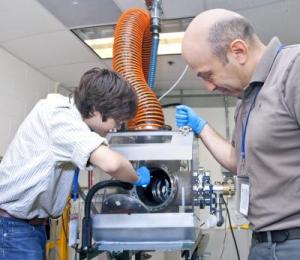Jun 10 2014
The U.S. Department of Energy's (DOE) Princeton Plasma Physics Laboratory (PPPL) has received some $4.3 million of DOE Office of Science funding, over three years, to develop an increased understanding of the role of plasma in the synthesis of nanoparticles.
Such particles, which are measured in billionths of a meter, are prized for their use in everything from golf clubs and swimwear to microchips, paints and pharmaceutical products. They also have potentially wide-ranging applications in the development of new energy technologies.
 Princeton Plasma Physics Laboratory (PPPL) physicist Yevgeny Raitses, right, with Washington University undergraduate Mitchell Eagles in the PPPL nanolaboratory. Credit: Elle Starkman/PPPL Office of Communications
Princeton Plasma Physics Laboratory (PPPL) physicist Yevgeny Raitses, right, with Washington University undergraduate Mitchell Eagles in the PPPL nanolaboratory. Credit: Elle Starkman/PPPL Office of Communications
"Plasma is widely used as a tool for producing nanoparticles, but there is no deep understanding of the role that plasma plays in this process," said physicist Yevgeny Raitses, the principal investigator for the project.
"Our goal is to develop an understanding that can lead to improved synthesis of these particles."
The new funds will expand research in a nanotechnology laboratory that PPPL launched in 2012 with PPPL Laboratory Directed Research and Development (LDRD) funds. The facility studies the complex interactions that occur when hot, electrically charged plasma gas is used as a synthesizing agent to produce material such as carbon nanontubes — items that are tens of thousands of times thinner than a human hair, yet stronger than steel on an ounce-per-ounce basis. These interactions must be precisely controlled to ensure the quality and purity of such material.
Many collaborators worked on the funding proposal for the new research. Key contributors included physicists Igor Kaganovich and Brent Stratton, who led the plasma theory and diagnostic sections of the proposal, respectively, and will continue to lead these project areas. Also essential were physicists Edward Startsev and Benoit LeBlanc, who worked on the theory and diagnostic parts of the proposal, respectively, and physicist Andrei Khodak, who contributed computer modeling.
Key collaboration also came from Predrag Krstic, a professor in the Institute for Advanced Computational Science at Stony Brook University, and Mikhail Shneider a senior research scientist in the Mechanical and Aerospace Department at Princeton University. Krstic is an expert on the atomistic computer modeling of materials; Shneider has invented new laser diagnostics for plasma applications.
Major contributors also include Bruce Koel, a Princeton professor of chemical and biological engineering, who will help characterize nanomaterials that come from the PPPL laboratory; Roberto Car, a Princeton professor of chemistry who will contribute to the atomistic modeling; Michael Keidar, a George Washington University professor of engineering and an expert on plasma nanotechnology; and Mohan Sankaran, an associate professor of chemical engineering at Case Western Reserve University and an expert on the plasma-based synthesis of nanoparticles.
Philip Efthimion, head of the Plasma Science and Technology Department at PPPL, provided guidance and support for the funding proposal. Olga Tishinin, a PPPL budget analyst, also provided key support.
In discussing the new research, PPPL Director Stewart Prager noted that, "The synthesis of nanoparticles is a challenging and exciting field with wide-ranging applications. This project combines our expertise in plasma science with the material science capabilities of Princeton University and other institutions."
The expanded research "fits right into our core competency," said Adam Cohen, PPPL deputy director for operations, who teamed with Prager to champion the initial development of the nanolaboratory, which was assembled with guidance from engineer Charles Gentile, and the new funding. "We've gained knowledge of plasma from our fusion research," Cohen said, "and this enables us to grow into a whole new research opportunity."